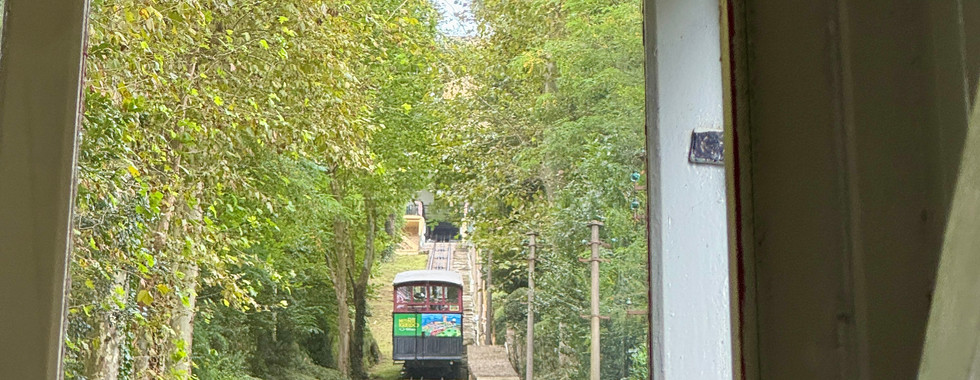Why You Need San Sebastián, Spain, On Your Bucket List
- Kimberly Gentry

- Oct 28
- 11 min read
Updated: Oct 29
San Sebastián, a unique jewel of Spain’s Northern coast, boasts stunning natural beauty, exceptional gastronomy and a dynamic cultural scene.
San Sebastián is a smaller city (population under 200,000) in the Basque region of Spain. From the flying of the Basque flag to culinary traditions, this heritage is a source of pride and ever-present culturally providing unique experiences for all who visit.

Palms trees, manicured plazas, topiaries overflowing with flowers and beautiful Belle Époque architecture are hallmarks of San Sebastián. For travelers, this seaside city is safe, clean and friendly. It’s also walkable with its most scenic views and popular things to do close together. So, let’s break down why you need San Sebastián, Spain, on your bucket list.
La Concha Beach and Bay
The pearl of San Sebastián is the famous La Concha Beach, widely ranked one of the most beautiful urban beaches in the world. La Concha has a grand and glamorous air that’s simultaneously relaxing and exciting.
The beach’s curved shoreline forms its iconic shell shape, hence the name La Concha, which translates to “The Shell.”
The Atlantic Ocean waters of Biscay Bay flow into the Bay of La Concha creating gentle waves perfect for surfing, swimming and boating. The beach is just under a mile long with soft sand that’s meticulously maintained by the city (groomed each morning).
La Concha, located in San Sebastián’s city center, connects to Ondarreta Beach in the Antiguo neighborhood. Together these beaches extend the curved shoreline for a total length of approximately 1.2 miles from the tree-covered hills of Mount Urgall on one end and Mount Igueldo on the other, hugging the entirety of La Concha Bay.
Although a small rock outcropping separates the La Concha and Ondarreta beaches, it's possible to walk the entire length of the bay thanks to a large tunnel that’s beautifully painted with an ocean-inspired motif.
Between Mount Urgall and Mount Igueldo, right in the middle of the bay is Santa Clara Island. Once home to a lighthouse keeper, today the island is a day-time destination for picnicking, hiking and enjoying the water.
The steep forested hills, bright blue water and sandy shores of La Concha Bay offer a stunning vista. It's no wonder the Spanish royal family built their summer residence, Miramar Palace, on a small hilltop rising up from the bay’s shore in the late 1800s. The former summer residence is now a cultural center hosting special community events.
Almost as iconic as La Concha Beach is the wide, plaza promenade featuring an ornate, white iron railing from the early 1900s that follows its shoreline. Beautiful historic hotels and residences line the promenade that’s filled with activity - diners at outdoor cafes, couples strolling hand-in-hand, joggers and leisure bicycle riders. Plus, outdoor sculptures by acclaimed artists, classic architecture and colorful landscaping. The heady atmosphere is jovial, romantic and beautiful.
The beach is only steps away thanks to short staircases and ramps that lead down from the promenade.
Travel Tips
• La Concha and Ondarreta are free public beaches.
• Restrooms, lockers and showers are available. Some facilities require a fee.
• La Concha beach is well lit at night so people often sit on the sand or walk along the water in the evening. People are always around on the beach or the plaza promenade. Night swimming is not encouraged, however.
• Santa Clara Island is accessible by a shuttle boat. People also can swim out to the island.
• Visit here for more details on visiting La Concha beach.
Culinary Scene
If you’re a foodie, your tastebuds will rejoice in San Sebastián. Considered one of the world’s culinary capitals, the scene is rooted in the Basque cooking tradition and taps into the area’s abundance of fresh seafood, meat and produce.
The city has the highest concentration of Michelin star restaurants than anywhere else in the world, but exceptional food extends beyond fine dining experiences to include traditional pintxos.
Hundreds of restaurants and bars prepare delicious, high-quality single bites known as pintxos (pronounced “PEEN-chos”). Pintxos originated in San Sebastián in the early 1900s and is the Basque region’s version of tapas except the food is served as one bite and usually eaten while standing up. Traditionally, these single bites are held together with a toothpick or small skewer. Each pintxo being a true single bite is liberally interpreted these days though.
The tradition of pintxos is to promote socializing and community. People pop into a pintxos bar, order a drink, eat a bite or two, visit with those around them and then move on to the next place and so on. It’s a food version of a pub crawl. Pintxos are commonly enjoyed with local ciders and Basque wines, such as a Txakoli (dry white wine) or a Riojo (red wine).
If you’d rather sit and eat, there are plenty of options for that, too. Many of the restaurants have both sit down service and pintxos.
Leave room for dessert, especially a slice of Basque cheesecake! Unlike New York style, Basque cheesecake is crustless and much creamier. This special treat is baked at a high temperature causing caramelization for a distinctive cracked, burnt appearance on the cheesecake's exterior.
Interested in pintxos and some cheesecake? Then head straight for historic Old Town, the heart and soul of pintxos in San Sebastián. The area is always lively as laughter and voices bounce off the stonewalls of centuries-old buildings while people gather around high top tables enjoying pintxos.
TN&G’s Favorite Old Town Places to Eat and their Specialties
Some places are pure, traditional pintxos bars with stand up dining only. Others offer a combo or are a traditional restaurant with pintxos on the menu. Pretty much every place will have a delicious ham croquette and probably a potato omelete on the menu. Both are practically food staples in Spain.
• La Cuchara de San Telmo - octopus; stewed beef cheek
• Antonio Boulevard - king prawn ravioli; crispy beef oxtail. It's not pintxos, but the raspberry gazpacho is yummy, too. (Great outdoor table area overlooking an active thoroughfare/urban park area).
• Bar Sport - mushroom croquette; grilled foie gras (may see name listed simply as "Sport")
• Atari - king prawn tails; calamari with aioli (nice location near Santa Maria Cathedral where lots of people gather on the steps and the small plaza).
• Restaurant Ubarrechena - crispy fried egg with bacon and potato
• La Viña - basque cheesecake (invented the recipe!)
Travel Tips
• Get the App! Download “Pintxos” and have the perfect guide for finding what your tastebuds will enjoy. The app details individual pintxos bars, including specialties, chef profiles and tasting routes. The app also includes information on operating hours and links to each bar's social media and website.
• Throughout Spain businesses, including restaurants close during the traditional afternoon siesta. Don’t fear, there are plenty of places that stay open to accommodate travelers from regions that don’t observe siestas.
• Spaniards typically have late dinners and enjoy socializing well into the evening. Again, this is reflected in the operating hours of bars and restaurants.
• Try the croquettes, especially ham. Croquettes are deep-fried with a crispy breadcrumb coating. Filling ingredients are combined with a creamy béchamel sauce.
• Iberian ham is hugely popular across Spain. This artisan, dry cured meat is from the legs of Black Iberian pigs from the Iberian Peninsula, which is Spain and Portugal combined. The deep red and marbled ham is extra tender and flavorful.
Old Town and Mount Urgall
Old Town is just steps from one end of La Concha Beach and a hub not just for pintxos, but also for shopping and enjoying historic sites, including the Cathedral of Santa Maria.
Old Town’s charming and narrow cobblestone streets, common in European historic districts, are always perfect for meandering and letting time and deadlines fade from your thoughts. Gelato shops are commonplace in Old Town, so stop in for a sweet treat and get “lost” for a little while.
If you head northward, the stone street next to the Cathedral of Santa Maria will transition to steep steps and a path that winds up the forested Mount Urgall to Castle La Mota, a 12th century military fortress.
The climb to La Mota is particularly steep and will take about 20-to-30 mins, but the pay off is worth it — the view of La Concha Bay and San Sebastian from the fortress is beautiful. From this high vantage point you can appreciate the bay’s unique shell shape, the blue-green water and the changing topography from steep hills to sandy beaches.
After snapping pics of those views, explore Castle La Mota. Mount Urgall is located at the mouth of La Concha Bay providing the fortress an ideal defensive position. The former fortress is spread across multiple levels and still has its ramparts and canons.
Atop the fortress is a huge statue of Jesus Christ, the “Sagrado Corazón” (“Scared Heart”). Built in 1950, the monument stands approximately 40 feet and serves as a San Sebastián landmark. When illuminated at night the statue seems to almost float above the city since it's surrounded by the darkness of Mount Urgall’s woods.
Not interested in a steep hike up Mount Urgall? Another scenic route is around Mount Urgall’s perimeter.
Steps near the Port of San Sebastián lead to a wide walkway, the Paseo Nuevo, that will take you past the city’s aquarium, anchored yachts and sailboats, a large outdoor sculpture and then continue all the way around to the other side of Mount Urgall. As you walk, you leave La Concha Bay and move into the Biscay Bay area.
The walkway is well above sea level providing scenic views and cool breezes. Imposing stone walls stretch down to the water where waves crash against it. Along the walkway people are fishing (with extra looong lines!), jogging, and taking pictures.
The outdoor sculpture, “Construcción Vacía” (“Empty Construction”) by Jorge Oteiza is a large, angular steel piece that’s an interesting contrast to the sea and hill on either side.
Shopping
In addition to restaurants, Old Town is a wonderful destination for finding specialty gifts. Nestled among the historic buildings are small shops with gourmet foods, confections, original art, clothing and handcrafted items.
Old Town and the City Center meld into one another and the shopping transitions into high end department stores with luxury brands to specialty clothing boutiques and everything in between.
A particularly wonderful store is Benegas Perfumeria. A family-owned business that stretches back four generations. In addition to selling well-known brands such as Chanel and Dior, Benegas formulates and sells its own scents as colognes, candles and bath products. They also feature a line of specialty shaving items.
Mount Igueldo
Opposite of Mount Urgall is Mount Igueldo. Like its sibling across the bay, Mount Igueldo is tall and tree covered, but that’s where the similarities end. Mount Igueldo is dotted with residences and its summit includes an amusement park, upscale hotel, restaurant and historic lighthouse.
The summit is reachable by car and walking (don’t recommend), but the most enjoyable way is by funicular, a cog railway that began operations in the early 1900s. Frankly, I was excited about riding the funicular, yet skeptical about what awaited at the top. An amusement park — how does that fit with the beauty and luxury of La Concha Beach?
Well, it does. It’s quaint and charming. The funicular began carrying people up Mount Igeuldo in 1911. For over 100 years, the summit has served as a sought after entertainment destination featuring amusement rides, dining and formerly a casino and ballroom.
It’s worth the trip up the hill just for the funicular experience, the incredible views, and a ride on the “Mysterious River” attraction.
For a unique way to see the bay, hop aboard The Mysterious River ride, which are little boats that travel along a water-filled concrete channel on the hill's steep edge. It's a joyful experience and the views of the bay are gorgeous.
Throughout the summit are lookout points for breathtaking views of La Concha and Biscay bays. Hands down, the best view of La Concha bay is from Mount Igeuldo (Mount Urgall’s views are partially obstructed by trees).
The amusement park is small with rides and games mostly geared toward families with young children. Although, there is a concrete roller coaster with one section that’s on the edge of the hill overlooking the steep ocean cliffs of Biscay Bay.
Another popular activity is to enjoy pintxos from the Nueve Leguas restaurant and sit on the deck facing La Concha Bay. For a little refinement, order a drink at the lounge bar inside the upscale Hotel Mount Igueldo, which is part of the Mercure hotel collection.
Just beyond the lobby, this large lounge is adorned with tasteful, modern decor and lined with floor-to-ceiling window panels. Settle into one of the oversized, comfortable leather chairs and relax while gazing at the ocean devoid of nautical traffic. Just miles and miles of blue-green water and the occasional sailboat or two. There’s also access to an outdoor deck if you want to enjoy the breeze.
At the base of Mount Urgall where the walkway dead ends at the mouth of the bay is a must-see art installation, “Peine del Viento” (“Wind Comb”) by famed Spanish sculptor Eduardo Chillida and architect Luis Pena Ganchegui.
Wind Comb is three abstract steel sculptures embedded into large rocks. They are unique as individual pieces, but also work together as a singular piece, yet how they work together varies based on where you stand to observe them. Water crashes around the rocks for a dramatic imagery.
Travel Tips
• There is no fee to enter the park. Pay per ride.
• Funicular makes a trip every 15 minutes. Tickets prices vary based on age and if making a round trip or not. Purchase at the station.
• There is a small fee to drive a car up Mount Igueldo.
• The funicular is not adaptable to wheelchairs.
• For more details, visit official website.
What Else is there to Do?
The San Sebastián Tourism website has links to numerous activities and museums across the city and just outside its walls. Here are some TN&G suggests:
• Just beyond Old Town, walk over to where the Urumea River flows out to sea and cross the Puente de Zurriola bridge. With its beautiful promenade featuring tall green and white lamposts, Zurriola is one of the series of bridges that cross the river as it winds through San Sebastián.
• San Sebastián hosts numerous festivals and special events. Notable ones include the Semana Grand (Big Week) in August, a multi-day, long celebration of food, music and an international fireworks competition. And, The Flag of La Concha regatta races on the bay. Held the first two Sundays in September, thousands of fans turn out to support as their community team in rowing competitions that connect to the region’s fishing boat history.
• For the ultimate in health and beauty, schedule an appointment at La Perla. Located on La Concha beach, La Perla specializes in a range of services, including thalassotherapy treatments that use algae, saltwater and other gifts from the ocean. La Perla also has terrace restaurants with beautiful bay views.
• Mount Iguello offers the best view of the entire bay, but if you don’t want to venture that far upward, TN&G’s pick is Miramar Palace. Situated on a small hill overlooking the bay, the palace grounds and gardens are open to the public for exploring. The front lawn is an ideal spot for a picnic or to just hang out and relax for a little while.
• Interested in seeing another piece of Chillida’s work? A granite sculpture by the artist is along the La Concha promenade. There is also the Chillida Leku Museum, an outdoor museum/sculpture park of his work that's about a 15 minute drive outside of San Sebastian.
When to Visit, Where to Stay and More Travel Tips
• The shoulder season months of early June and September are ideal for milder weather and less people.
• August is the busiest month (holiday time for Spaniards) so expect crowded beaches.
• October – December is San Sebastián’s rainy season.
• The bay water is at its warmest in August. Generally, the water is cool.
• Don’t be confused by signs that read “Donostia-San Sebastián.” Donostia is the Basque word for San Sebastián. Although Spanish is widely spoken, the region still embraces the Basque language.
• If you can, stay in one of the beachfront hotels (in a waterview room) that’s just a short walk to the best features of San Sebastián. TN&G highly recommends the historic Hotel Londres for its elegance, exceptional service and ideal location. Another well-regarded beachfront option is Villa Favorita.
• For more details about San Sebastián beyond the La Concha Bay area, visit the city's tourism department website.




























































































